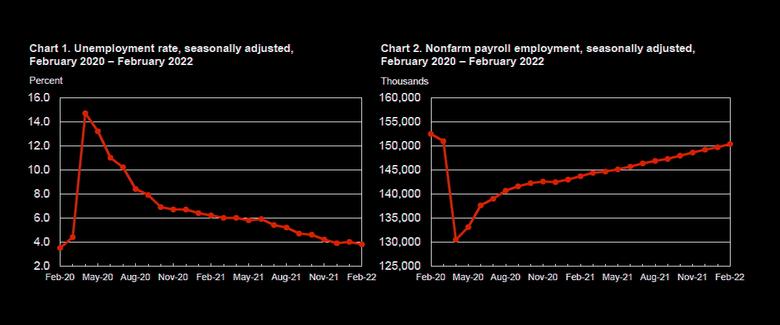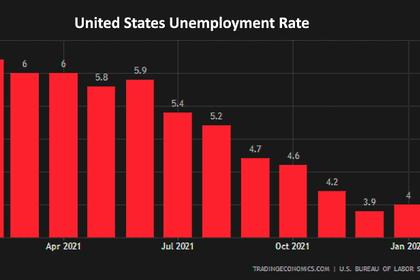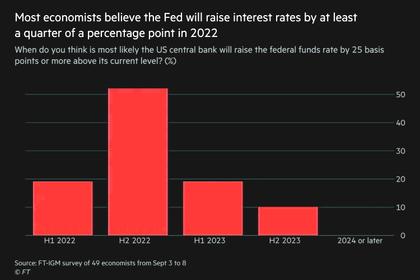
U.S. EMPLOYMENT UP BY 678,000

U.S. BLS- March 4, 2022 - THE EMPLOYMENT SITUATION — FEBRUARY 2022
Total nonfarm payroll employment rose by 678,000 in February, and the unemployment rate edged down to 3.8 percent, the U.S. Bureau of Labor Statistics reported today. Job growth was widespread, led by gains in leisure and hospitality, professional and business services, health care, and construction.
This news release presents statistics from two monthly surveys. The household survey measures labor force status, including unemployment, by demographic characteristics. The establishment survey measures nonfarm employment, hours, and earnings by industry. For more information about the concepts and statistical methodology used in these two surveys, see the Technical Note.
Household Survey Data
In February, the unemployment rate edged down to 3.8 percent, and the number of unemployed persons edged down to 6.3 million. In February 2020, prior to the coronavirus (COVID-19) pandemic, the unemployment rate was 3.5 percent, and the number of unemployed persons was 5.7 million. (See table A-1.)
Among the major worker groups, the unemployment rates for adult men (3.5 percent) and Hispanics (4.4 percent) declined in February. The jobless rates for adult women (3.6 percent), teenagers (10.3 percent), Whites (3.3 percent), Blacks (6.6 percent), and Asians (3.1 percent) showed little or no change over the month. (See tables A-1, A-2, and A-3.)
Among the unemployed, the number of persons on temporary layoff, at 888,000 in February, was little changed over the month. The number of permanent job losers, at 1.6 million in February, also changed little. Both measures are higher than their February 2020 levels of 780,000 and 1.3 million, respectively. (See table A-11.)
In February, the number of persons jobless less than 5 weeks declined by 286,000 to 2.1 million. The number of long-term unemployed (those jobless for 27 weeks or more) was essentially unchanged at 1.7 million. This measure is 581,000 higher than in February 2020. The long-term unemployed accounted for 26.7 percent of the total unemployed in February 2022. (See table A-12.)
The labor force participation rate, at 62.3 percent in February, changed little over the month. The employment-population ratio edged up to 59.9 percent. Both measures remain below their February 2020 levels (63.4 percent and 61.2 percent, respectively). (See table A-1.)
The number of persons employed part time for economic reasons increased by 418,000 to 4.1 million in February but remains below its February 2020 level of 4.4 million. These individuals, who would have preferred full-time employment, were working part time because their hours had been reduced or they were unable to find full-time jobs. (See table A-8.)
The number of persons not in the labor force who currently want a job declined by 349,000 to 5.4 million in February. This measure is above its February 2020 level of 5.0 million. These individuals were not counted as unemployed because they were not actively looking for work during the 4 weeks preceding the survey or were unavailable to take a job. (See table A-1.)
Among those not in the labor force who wanted a job, the number of persons marginally attached to the labor force, at 1.5 million, changed little in February. These individuals wanted and were available for work and had looked for a job sometime in the prior 12 months but had not looked for work in the 4 weeks preceding the survey. The number of discouraged workers, a subset of the marginally attached who believed that no jobs were available for them, was little changed over the month at 391,000. (See Summary table A.)
Household Survey Supplemental Data
In February, 13.0 percent of employed persons teleworked because of the coronavirus pandemic, down from 15.4 percent in the prior month. These data refer to employed persons who teleworked or worked at home for pay at some point in the 4 weeks preceding the survey specifically because of the pandemic.
In February, 4.2 million persons reported that they had been unable to work because their employer closed or lost business due to the pandemic—that is, they did not work at all or worked fewer hours at some point in the 4 weeks preceding the survey due to the pandemic. This measure is down from 6.0 million in the previous month. Among those who reported in February that they were unable to work because of pandemic-related closures or lost business, 20.3 percent received at least some pay from their employer for the hours not worked, down from 23.7 percent in January.
Among those not in the labor force in February, 1.2 million persons were prevented from looking for work due to the pandemic, down from 1.8 million in the prior month. (To be counted as unemployed, by definition, individuals must be either actively looking for work or on temporary layoff.)
These supplemental data come from questions added to the household survey beginning in May 2020 to help gauge the effects of the pandemic on the labor market. The data are not seasonally adjusted. Tables with estimates from the supplemental questions for all months are available online at www.bls.gov/cps/effects-of-the-coronavirus-covid-19-pandemic.htm.
Establishment Survey Data
Total nonfarm payroll employment rose by 678,000 in February but is down by 2.1 million, or 1.4 percent, from its pre-pandemic level in February 2020. Job growth was widespread over the month, led by gains in leisure and hospitality, professional and business services, health care, and construction. (See table B-1.)
Employment in leisure and hospitality continued to increase, with a gain of 179,000 in February. Job growth occurred in food services and drinking places (+124,000) and in accommodation (+28,000). Since February 2020, employment in leisure and hospitality is down by 1.5 million, or 9.0 percent.
Professional and business services added 95,000 jobs in February. Job gains occurred in temporary help services (+36,000), management of companies and enterprises (+12,000), management and technical consulting services (+10,000), and scientific research and development services (+8,000).
Employment in professional and business services is 596,000 higher than in February 2020, largely in temporary help services (+240,000), computer systems design and related services (+154,000), and management and technical consulting services (+152,000).
Employment in health care rose by 64,000 in February. Job gains occurred in home health care services (+20,000), offices of physicians (+15,000), and offices of other health practitioners (+12,000).
Employment in health care is down by 306,000, or 1.9 percent, from its level in February 2020.
Construction added 60,000 jobs in February, following little change in the prior month. About threefourths of the over-the-month job gain occurred in specialty trade contractors, with increases in both the residential (+24,000) and nonresidential (+20,000) components. Construction employment is slightly below (-11,000) its February 2020 level.
Employment in transportation and warehousing increased by 48,000 in February and is 584,000 higher than in February 2020. Over the month, job gains continued in warehousing and storage (+11,000), couriers and messengers (+9,000), support activities for transportation (+9,000), and air transportation (+7,000). All four of these component industries have surpassed their February 2020 employment levels, with particularly strong job growth in warehousing and storage (+420,000) and couriers and messengers (+240,000).
Employment in retail trade rose by 37,000 in February, with gains in building material and garden supply stores (+12,000), furniture and home furnishings stores (+6,000), and gasoline stations (+5,000).
Retail trade employment is 104,000 above its level in February 2020.
Manufacturing added 36,000 jobs in February. Employment in durable goods industries rose by 20,000, with job gains in fabricated metal products (+11,000), machinery (+8,000), electrical equipment and appliances (+4,000), nonmetallic mineral products (+3,000), furniture and related products (+3,000), and primary metals (+3,000). These gains were partially offset by a job loss in motor vehicles and parts (-18,000). Nondurable goods manufacturing also added jobs over the month (+16,000). Since February 2020, manufacturing employment is down by 178,000, or 1.4 percent.
In February, employment in financial activities rose by 35,000. Job gains were split between finance and insurance (+16,000) and real estate (+16,000). Employment in financial activities is 31,000 above its level in February 2020.
Social assistance added 31,000 jobs in February, with a gain of 21,000 jobs in individual and family services. Since February 2020, employment in social assistance is down by 152,000, or 3.5 percent.
Employment increased by 25,000 in the other services industry in February, led by a gain in repair and maintenance (+10,000). Employment in the other services industry is down by 317,000, or 5.3 percent, from its level in February 2020.
Wholesale trade added 18,000 jobs in February; employment in the industry is 113,000, or 1.9 percent, lower than in February 2020.
Mining employment rose by 9,000 in February, with gains in support activities for mining (+6,000) and in oil and gas extraction (+2,000). Mining employment has grown by 62,000 since a recent low in February 2021.
Employment showed little or no change over the month in information and government.
Average hourly earnings for all employees on private nonfarm payrolls, at $31.58 in February, were little changed over the month (+1 cent), after large increases in recent months. Over the past 12 months, average hourly earnings have increased by 5.1 percent. In February, average hourly earnings of privatesector production and nonsupervisory employees rose by 8 cents to $26.94. (See tables B-3 and B-8.)
The average workweek for all employees on private nonfarm payrolls rose by 0.1 hour to 34.7 hours in February. In manufacturing, the average workweek for all employees increased by 0.4 hour to 40.7 hours, and overtime rose by 0.2 hour to 3.6 hours. The average workweek for production and nonsupervisory employees on private nonfarm payrolls was up by 0.1 hour to 34.1 hours. (See tables B-2 and B-7.)
The change in total nonfarm payroll employment for December was revised up by 78,000, from +510,000 to +588,000, and the change for January was revised up by 14,000, from +467,000 to +481,000. With these revisions, employment in December and January combined is 92,000 higher than previously reported. (Monthly revisions result from additional reports received from businesses and government agencies since the last published estimates and from the recalculation of seasonal factors.)
-----
Earlier:















